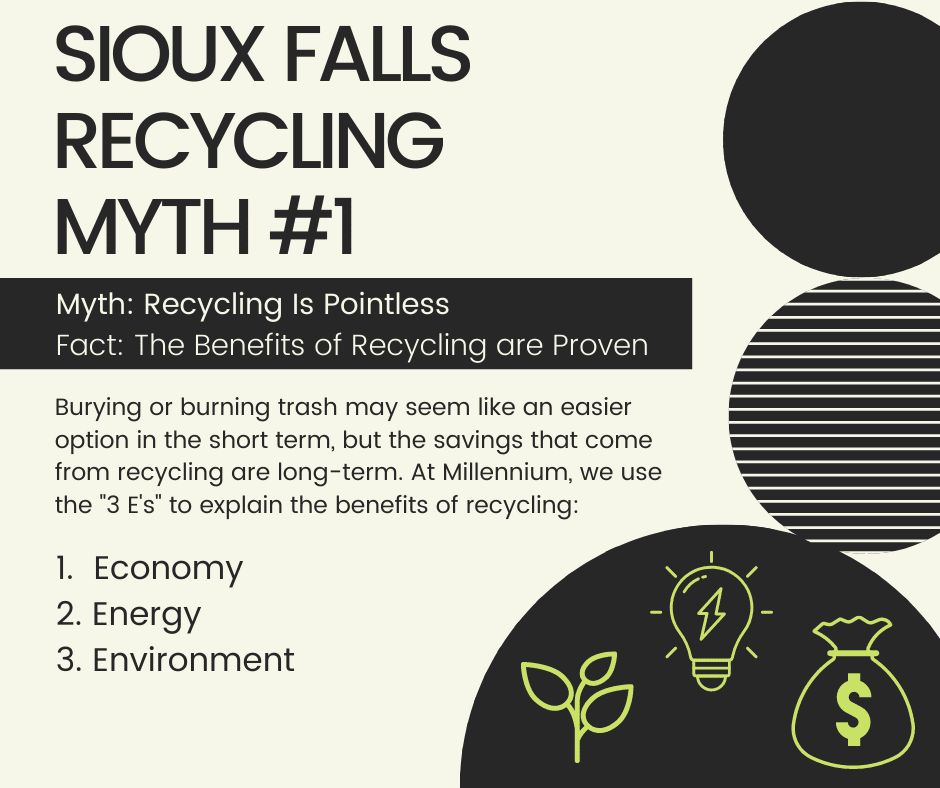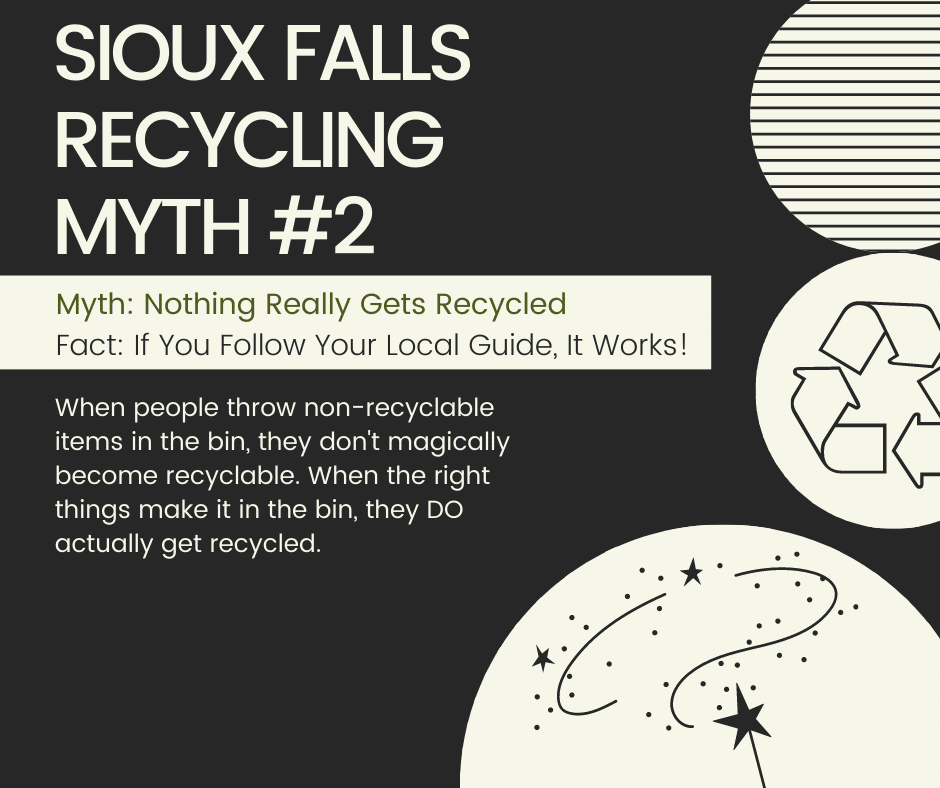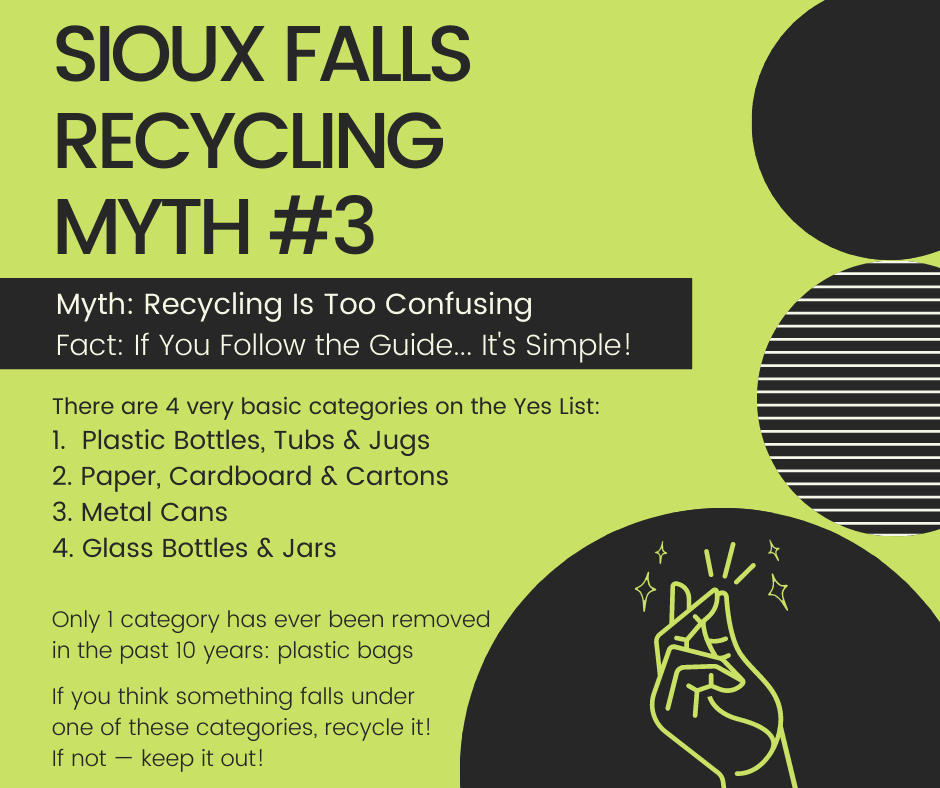Recycling really does work in Sioux Falls… and is an ESSENTIAL part of our community!
First, let’s address the biggest problem facing the recycling industry: PLASTIC.
Plastic is a problem, while it’s important to recycle the type of plastic that can actually be recycled, we must also hold manufacturers accountable for the majority of plastic they produce that can’t be recycled.
TOP THREE RECYCLING MYTHS
Want to know more about why recycling really does work?
Let’s answer the three most common myths we hear locally when talking about recycling and back it up with some FACTS:
MYTH #1: Recycling is Pointless!
Fact: The Benefits of Recycling are Proven.
B urying or burning trash may seem like an easier option in the short term, but the savings that come from recycling are long-term. At Millennium, we use the “3 E’s” to explain the benefits of recycling:
urying or burning trash may seem like an easier option in the short term, but the savings that come from recycling are long-term. At Millennium, we use the “3 E’s” to explain the benefits of recycling:
[Economy] By reducing the amount of waste sent to landfills, recycling saves landfill space. Building new landfill cells, along with maintaining closed ones, is VERY expensive. By recycling, we are directly supporting local private businesses in our community like waste haulers, material recovery facilities, and processors, all while reducing the need for more public funding to continue expanding the landfill.
Recycling generates good, stable jobs — as many as 9 times more than trash. With positions ranging from material sorting and equipment maintenance, to brokers and sales representatives, to process engineers and chemists, there are MANY different types of critical jobs along the recycling process being created.
Recycling supplies a reliable, domestic source to meet the demand for raw materials for U.S. manufactured goods and supplies – in fact, recycling supplies 40% (on average across all commodities) of raw material needs for U.S manufacturing! This reduces our reliance on imports which has proven to be more important than ever before with the current feedstock shortage impacting small manufacturers and disrupting our nation’s supply chain resiliency.
[Energy] It takes a lot of energy and water to extract and refine virgin materials from the earth. When things are dumped in the landfill, the energy used to make them is lost. Although some energy can be recovered from capturing methane gas or waste incineration, using recycled materials to make new products takes significantly less energy than either of these options, even after accounting for recycling collection, processing and transportation.
Recycling aluminum uses 95% less energy than using virgin material. One ton of recycled paper uses 64% less energy than from virgin wood pulp. Steel and tin cans save 60-74% of the energy used to produce them from raw materials. Recycled plastic uses only two-thirds of the energy compared to raw materials. And producing glass from silica mining requires 30% more energy than from crushed, recycled glass.
[Environment] From a sustainability point of view, recycling has great value. The simple choice to recycle reduces the amount of waste being sent to landfills and incinerators, allowing us to conserve natural resources and prevent pollution. Critics argue that we aren’t running out of landfill space any time soon and there’s nothing wrong with burying it all, but the problem is people don’t want to live near landfills.
Rotting waste produces methane gas and a mixture of liquid chemicals called leachate. If not properly contained and or treated, this leads to air pollution and can slowly seep into groundwater used for crops and tap water, causing serious health risks. According to the EPA, even modern landfills with new clay and plastic liners will ultimately fail.
Incinerators are not a perfect solution either, as they release heavy metals and toxic chemicals into the air. It’s very difficult to justify building a new landfill or incinerator when we could be preventing the need for them by recycling.
MYTH #2: Recycling is Pointless!
Fact: The Benefits of Recycling are Proven.
 When people throw non-recyclable items in the bin, they don’t magically become recyclable. When the right things make it in the bin, they DO actually get recycled:
When people throw non-recyclable items in the bin, they don’t magically become recyclable. When the right things make it in the bin, they DO actually get recycled:
[Getting it Right] When the right things are placed in the bin, recycling works. At Millennium, our single stream sorting process separates the materials we’ve identified on the Yes List. These materials are used by regional and US based manufacturers who rely on us to provide this raw material for their products. Because our single stream process is efficiently setup to collect and sort these items, less than 5% of the material we receive at our facility is landfilled (and when we say landfilled… it’s because it is truly trash that we have pulled out from the Yes items and have no place to send it). That’s significantly better than the national average of 25%. This shocking accomplishment can be attributed to customer education, waste hauler efforts, efficient sorting processes, and strong end-user relationships. However, contamination is still one of the biggest challenges and expenses we face. Now more than ever we need to focus on reducing confusion through more education, increasing enforcement to keep people responsible, and improving the process through technology innovations.
[Wishful Recycling] Although enthusiasm for recycling is strong, the stuff people throw in their bin often does more harm than good. Consumer confusion has led to the recycling bin being used as a second garbage can. Contamination includes things like food waste, liquids, dirty diapers and yard waste that can ruin good material. Items like scrap metal, wood waste and “tanglers” can also damage equipment. Other dangerous items like used needles or sharp knives can put workers at risk. A combination of ‘wishful recycling’ and not enough repercussions from putting the wrong stuff in the bin has taken its toll.
[Making it in the Bin] In order to be recycled, recyclable items need to actually make it in the bin! An astonishing 91% of plastic created has not been recycled: 79% has accumulated in landfills or the natural environment, 12% was incinerated, and just 9% has been recycled. Most of this is due to the non-recyclability of so many plastic products being manufactured, but some of it is that people just aren’t recycling. Single stream has helped by allowing recyclable material to be placed into one, single bin – greatly increasing participation and efficiency with some communities reporting a 500% increase in recycling, but also proving to be a challenge on the contamination. If the process is not set up correctly, contamination can get out of control very quickly and workers must pull out anything that is not recyclable or recognized by the equipment. If contaminants aren’t removed, the value of the material is extremely diminished.
MYTH #3: Recycling is Too Confusing.
Fact: If you follow the Guide…It’s Simple!
 [Follow the Yes List] Recycling is just as easy as throwing something in the garbage. We have defined 4 very basic categories to keep the recycling “Yes List” as simple as possible.
[Follow the Yes List] Recycling is just as easy as throwing something in the garbage. We have defined 4 very basic categories to keep the recycling “Yes List” as simple as possible.
[It Doesn’t Change] Since Single Stream began in 2009, only one category has ever been removed (plastic bags), however, some items have been added (cartons, paper cups).
[When in Doubt, Keep it Out] The rule of thumb is if you think it falls under one of these four categories, recycle it! If not – keep it out! And if you’re still not sure, use Facebook or Millennium’s website to simply ask, that’s what we’re here for.

 Have a Recycling Question? Contact Us!
Have a Recycling Question? Contact Us!